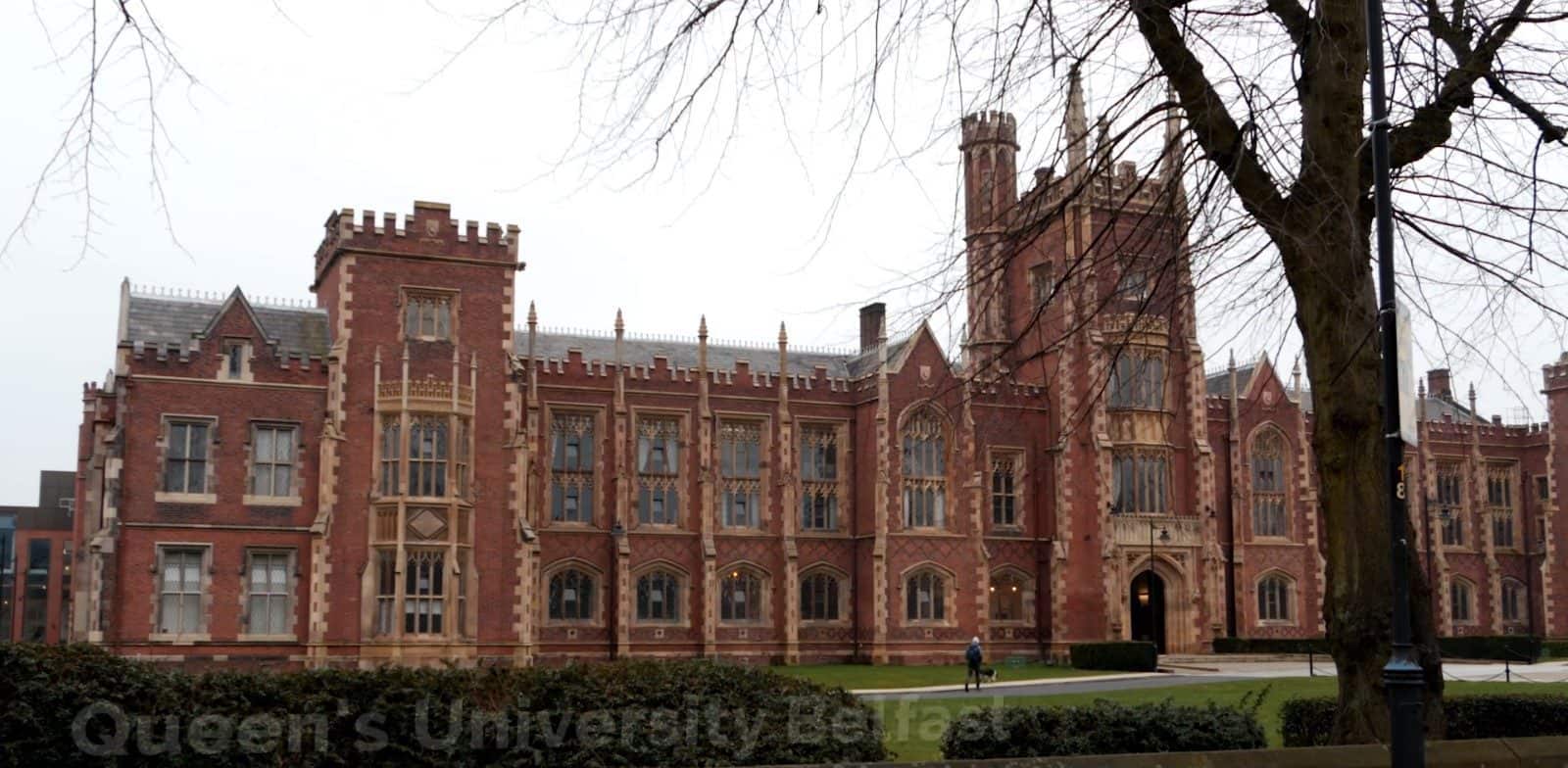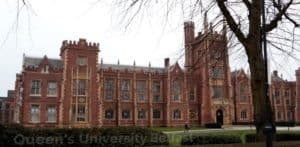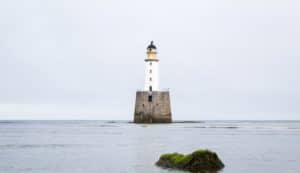Queen’s University Belfast: Past, Present and Future

Updated On: May 28, 2024 by Marise
Queen’s University Belfast is one of the leading universities in the UK, providing world-class education underpinned by world-class research… where did it all begin? Keep reading to learn more about this iconic Belfast, Northern Ireland University.
Table of Contents
History of Queen’s University
Past: The Foundation and Evolution
Establishment and Early Years
Queen’s University Belfast was established by Queen Victoria’s Royal Charter in 1845 as part of the Queen’s Colleges in Belfast, Cork, and Galway. The aim was to provide non-denominational higher education in Ireland. The foundation stone of the main building, the iconic Lanyon Building, was laid in 1849. Designed by the English architect Sir Charles Lanyon, the building symbolises the university’s heritage.
Significant academic achievements and the establishment of a robust educational framework marked the early years of Queen’s College Belfast. Initially, it comprised faculties of Arts, Medicine, and Law, strongly emphasizing the provision of quality education to students from all backgrounds.
Development and Expansion
The latter half of the 19th century saw the college expanding its curriculum and facilities. The introduction of new disciplines and the construction of additional buildings indicated its growth. The institution played a crucial role in the educational and cultural development of Belfast, which was, at that time, an industrial hub.
In 1908, Queen’s College Belfast became a full-fledged university known as The Queen’s University of Belfast. This transition marked a new era of autonomy and academic freedom, allowing the university to broaden its educational and research horizons.
World Wars and Social Change
The two World Wars had a profound impact on Queen’s University Belfast. During these tumultuous times, the university community played a significant role in supporting the war efforts through research and innovation. Post-war periods brought substantial social and economic changes, influencing the university’s structure and policies.
The mid-20th century was a time of significant social change in Northern Ireland, and Queen’s University Belfast was at the heart of many of these transformations. The university expanded its campus, introduced new faculties, and increased student intake. It also began to emphasise research, establishing itself as a major centre for scholarly activity.
Present: A Global Leader in Education and Research
Academic Excellence
Today, Queen’s University Belfast is renowned for its academic excellence and cutting-edge research. It consistently ranks among the top universities in the UK and globally. The university offers various undergraduate and postgraduate programmes across multiple disciplines, including Arts, Humanities, Social Sciences, Medicine, Engineering, and Natural Sciences.
The university’s commitment to providing high-quality education is reflected in its teaching standards, regularly recognised through various awards and accolades. It boasts a distinguished faculty comprising leading academics and researchers who are experts in their respective fields.
Research and Innovation
Queen’s University Belfast is a powerhouse of research and innovation. It is a Russell Group member, representing 24 leading public research universities in the UK. The university’s research strategy focuses on addressing global challenges and positively impacting society.
The institution has significantly contributed to various fields, including health sciences, engineering, and social sciences. The Centre for Cancer Research and Cell Biology, the Institute for Global Food Security, and the Centre for Wireless Innovation are just a few examples of the university’s research centres making groundbreaking advancements.
Community Engagement and Social Responsibility
Queen’s University Belfast is deeply committed to its community and social responsibility. The university actively engages with local communities through various outreach programmes, partnerships, and initiatives to promote education, health, and social well-being.
The university’s Widening Participation Unit ensures that higher education is accessible to all, regardless of background or socio-economic status. This commitment to inclusivity and diversity is central to the university’s mission.
Campus and Facilities
The university’s campus blends historic architecture with modern facilities, creating an inspiring environment for learning and research. The Lanyon Building, with its Gothic-style architecture, remains a focal point, while new state-of-the-art facilities have been developed to cater to the evolving needs of students and staff.
The McClay Library, the Graduate School, and the newly opened Biological Sciences building are just a few examples of the university’s investment in providing top-notch facilities. These developments ensure that students and researchers have access to the resources they need to excel.
Student Life and International Community
Queen’s University Belfast offers a vibrant student life with various extracurricular activities, clubs, and societies. The Students’ Union is crucial in representing student interests and organising events that enhance the university experience.
The university is also home to a diverse international community, with students and staff from over 80 countries. This multicultural environment enriches the educational experience and fosters a global perspective among students.
Future: Vision and Prospects
Strategic Vision
Looking ahead, Queen’s University Belfast is focused on further enhancing its global reputation and impact. The university’s strategic vision, “Strategy 2030”, outlines ambitious goals to consolidate its position as a world-leading institution.
The strategy focuses on critical areas such as advancing research excellence, enhancing the student experience, fostering global partnerships, and promoting sustainability. A commitment to innovation, collaboration, and societal impact underpins these goals.
Research and Innovation
In the future, Queen’s University Belfast aims to build on its research strengths and continue making significant contributions to addressing global challenges. The university is poised to lead in areas such as health and life sciences, digital innovation, sustainability, and social justice.
Investments in cutting-edge research facilities and collaborations with industry partners will drive innovation and translate research into real-world solutions. The university’s interdisciplinary approach will be vital in tackling complex global issues.
Global Engagement
Queen’s University Belfast is committed to strengthening its global presence through strategic partnerships with leading institutions worldwide. These collaborations will enhance research capabilities, provide international opportunities for students and staff, and contribute to the university’s global impact.
The university’s focus on internationalisation will also involve increasing the diversity of its student body and fostering a global perspective within its curriculum. This approach will prepare students to thrive in an interconnected world and contribute to international society.
Sustainability and Social Responsibility
As it looks to the future, sustainability is a core priority for Queen’s University Belfast. The university is dedicated to reducing its environmental footprint and promoting sustainable practices across its campus. Initiatives such as the Green Campus Programme and establishing a Centre for Sustainability demonstrate this commitment.
Social responsibility will continue to be a guiding principle for the university. Queen’s University Belfast will maintain its focus on widening access to education, supporting community development, and addressing social inequalities. These efforts will ensure that the university remains a positive force for change.
Enhancing the Student Experience
The future of Queen’s University Belfast is centred on providing an exceptional student experience. To enhance the overall student journey, the university plans to invest in state-of-the-art facilities, innovative teaching methods, and comprehensive support services.
Emphasis will be placed on personalised learning, employability, and mental health and well-being. The goal is to equip students with the knowledge, skills, and resilience needed to succeed in their careers and personal lives.
Alumni and Lifelong Learning
Queen’s University Belfast recognises the importance of its alumni network and its role in the university’s future. The university will continue to engage with its alumni community, fostering lifelong connections and providing opportunities for ongoing learning and professional development.
Initiatives such as alumni mentoring programmes, networking events, and continuous education offerings will ensure that graduates remain connected to the university and benefit from its resources throughout their lives.
The Lanyon Building and the Entrance Hall

Queen’s University Belfast is one of the city’s most iconic and stunning architectural pieces. The Centrepiece is The Lanyon Building, which opened in 1849 and is named after its architect, Sir Charles Laynon.
Shockingly, this stunning piece of architecture is not as gorgeous as the original plans intended! The budget limited the original plans. This part of Queen’s Estate is the most recognisable and is often used in tourist videos and posters to showcase the City. His building design was influenced by the Gothic and Tudor characters of the great medieval universities, notably Magdalen College, Oxford. Laynon has also designed a few other noticeable landmarks in the city, such as Customs House, Belfast Castle and Crumlin Road Gaol. The campus also contains over 100 buildings with exceptional architectural and historic merit.
Today, Queen’s University Belfast, has over 300 buildings, but the Lanyon remains the main building, arguably, one of the most beautiful buildings in Belfast. Established architect Sir Charles Lanyon was appointed to plan this building. Most of the original plans were drawn up by William Henry Lynn, apprentice of Charles Lanyon.
Many of the original details not used for the building can be found in William Henry Lynn’s plans, which cost 30 percent over the budget. The main entrance was originally to feature a grand Gothic door and window on one wall leading to an examination hall. This was one of the first cuts in the plan to save money. Instead, J E Nuttgens designed a more straightforward window in 1939. It was not added until after WWII.
Sir Charles Lanyon’s final design, sandstone and soft red brick reflects the culture of the time; the historical architecture creates an appearance of authority. The Lanyon building is surrounded by grass at the front and in the quadrangle.
The Lynn Hall
Constructed between 1866 and 1868, Lynn Hall was the original University Library. It was named after the architect who designed it, William Henry Lynn. He created it in a neo-gothic style, which was very famous then. The Library opened in 1868 due to the rising number of students. Later, Lynn extended the building to the east in 1911, and it was completed in 1913.
The Great Hall
Before the Lynn Hall was funded, the Great Hall functioned as an examination hall and a library. Taking inspiration from medieval halls of Oxbridge colleges: the oriel window, a raised dais and a fireplace for the top table. However, similar to the Lanyon, it suffered due to lack of funds: the gallery was never built, and simple panelling was designed.
Today
Queen’s University Belfast’s current intake is 23,000 students from all over the world. The campus is ever-growing: The McClay Library was opened in 2009; two new student accommodation buildings opened during the Summer of 2018 in Belfast city centre; and the new School of Biological Sciences opened in 2019. With much success, Queen’s University Belfast will grow each year in terms of student intake and geography.
The Lanyon Building and Main Entrance
The grand centrepiece of this hall is Pio Fedi’s statue of Galileo, which was added in 2001. You can see the only remaining part of the original design from the quadrangle, the year “1848” marked on the Lanyon’s south wing. The south wing is the only part of the original design.
The Lynn Hall
In 2009, the library moved to the new McClay Library, which underwent renovation in 2015 before becoming the graduate school. Now, as the graduate school, it is a modern space; however, it still contains many of its original designs, such as the vaulted ceiling, gothic arches, and gargoyles. There remains a memorial plaque for the architect William Henry Lynn.
The Great Hall
In 2000, Consarc Conservation architects restored the Great Hall. The restored organ from Christchurch was installed, and above the fireplace, a bronze plaque in memory of Thomas Hamilton (the first president of the University) was placed.
The restoration received a RIBA Award in 2001. It is now used as a refectory, examination hall and venue for formal occasions, conferences and exhibitions. The walls are covered with portraits of important people such as Queen Victoria (founder) and Nobel Laureate Seamus Heaney.
Famous Faces
Due to Queen’s University Belfast’s proud history and ever-growing facilities, it is not surprising that many famous people have studied at this campus.
Nobel Laureate Seamus Heaney: An Irish writer, studied at St Columb’s College, Derry/ Londonderry, before attending, graduating and lecturing at Queen’s University Belfast.
Liam Neeson is an Irish actor who studied physics and computer science at Queen’s University Belfast. However, he was removed from the university’s Prospectus in March 2019.
Mary McAleese: Graduated with a Law degree from Queen’s University Belfast in 1973. In 1997, she was voted the eighth President of Ireland. She was the only person from Northern Ireland to hold the Irish Presidency, the first from Northern Ireland, and the second-ever female.
Annie Mac: Studied English at Queen’s University Belfast. She is an Irish DJ and television presenter.
Lisa McGee is an Irish stage and screenwriter born and raised in Derry, London—drama graduate from Queen’s University Belfast in 2002.
Máire O’Neill, Meng 1999 – Won British Female Inventory in 2007: She is widely recognised as one of Europe’s leading cryptography experts to enhance data security worldwide. She is among only five engineers to win the Royal Academy of Engineering Silver Medal for contributing to society in 2014.
Patrick Kielty, BSc Psychology 1992 – He is a stand-up comedian well known for his TV presentation. Patrick is one of Northern Ireland’s most recognised and celebrated entertainers.
Seamus Healy, BA English 1961—He is known as one of the world’s best-known poets, and his work has been highly acclaimed. Besides being an Irish poet, he was a playwright, translator, and even lecturer at Queen University on Modern English Literature. Seamus also won the Nobel Peace Prize in 1995 for Literature.
In the comments below, please let us know if you have ever been a student at Queen’s University and what your experience was like.
Other blogs you may like: St. Georges Market | Laverys Belfast | Belfast Castle | Good Vibrations in Belfast | Botanic Gardens, Belfast | St. Anne’s Cathedral






